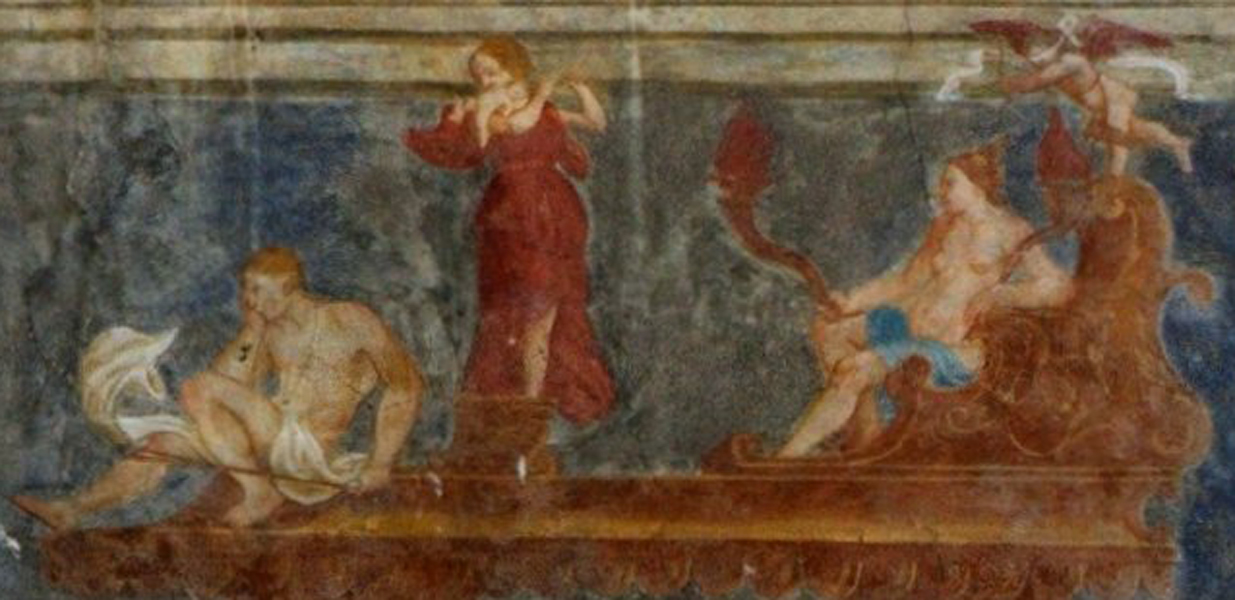Thanks for those translations, and for bringing the Casa Rella frescoes to our notice, Marco.
I've been thinking about this "Triumph of Love" (so-called; it IS Love's chariot, although Death is the final image).
 http://www.rosscaldwell.com/images/triu ... foamor.jpg
http://www.rosscaldwell.com/images/triu ... foamor.jpg
(Although the scene moves from right to left, the caption reads it from left to right, as if it were a procession passing by.)
The images on the Chariot puzzled me:
 http://www.rosscaldwell.com/images/triu ... fo1det.jpg
http://www.rosscaldwell.com/images/triu ... fo1det.jpg
The figure driving the chariot, holding the reins, with his chin on his hand, is obviously "sluggishness" or "sloth".
The text then says that "saevities" (
saevitia; rage, cruelty) and "suspitio" (
suspicio) are in front of the King, and that the King is Love himself.
So provisionally, I identified Cupid as the King. Then, the standing woman who appears to be pulling a baby's hair and even biting it must be
saevitia. But where is
suspicio? The reclining woman with two flaming
cornucopiae seems to be sitting in the place of the King... so I went looking for iconography of
suspicio, without finding anything.
More and more, it seemed that the reclining woman has to be Venus, the mother of Cupid, and that
together they are
rex ipse amor, the King, Love himself. So two personifications become one.
But, there is no one else on the car who can answer to
suspicio. I have to think then that the standing woman, in contrast to the Venus-Cupid pair, is one image standing for two. She is
both rage and jealousy. I think this is the only plausible reading of the chariot scene. What do you (or anyone else) think?
The reason I retitled the post is because I still find this sequence to be the best cognate for Tarot's "middle section", Love to Death. It is a century later and obviously telling a different story, but it is telling it in the same manner - single personfications - and with many of the same images, as the Tarot trumps. For Riches, Beauty and Grace, let us say some of the gifts of a good life, the Tarot instead uses the three virtues to remind us of the rewards they bring. Tarot also inserts Fortune (which is present elsewhere on the Casa Rella wall), to show that none of these "possessions" can be relied on; Fortune can and probably will take them, either by Time (or Old Age) or Treachery.
Another interesting thing about the fresco is the personification of "tristis pudor", which you have translated, properly I think, as "sad shame."
Pudor is indeed modesty or shame (as in bashfulness), but with the adjective
tristis added, and the aspect of the visual image as being full of regret, I think the stronger sense of "shame" is very strongly implied. "Sad modesty" makes no sense, either conceptually or in light of the iconography. This brought to my mind Moakley's interpretation of the Hanged Man as a
Shame Painting.
To me the juxtaposition of Time and Shame or Disgrace of some sort in both this fresco and in Tarot, is very striking. And in both they are followed immediately by Death.
The accompanying inscription makes me think that Tarot had something like that too. A skeletal narrative, with a few fixed points. Some of the details, like the exact order of Riches, Beauty and Grace, or even Time and Shame, are not important; what is important is that they are in
that section - leading, or following, the chariot. And in my theory of the Ur-Tarot, I think it is important that the Virtues are before the Wheel of Fortune, but I don't think it is important what order they appear in.
The position of the Chariot is arguable, even from an A or Southern perspective, since both before
and after the virtues is known (and even, in Florence, after Fortune). I think eveyrone knows that I favour the Bolognese order, which is the same as the Tarot de Marseille - Love-Chariot-Virtue(s).



